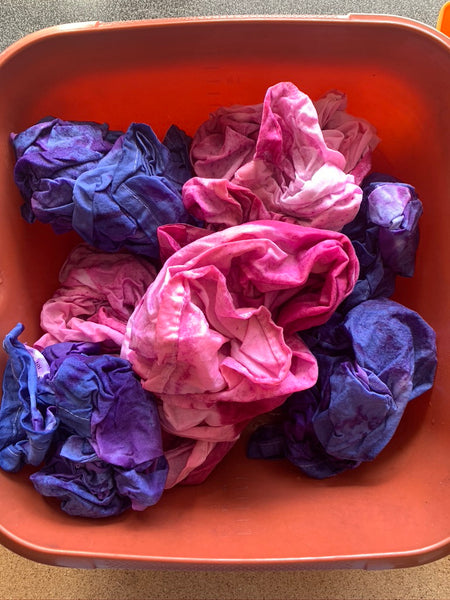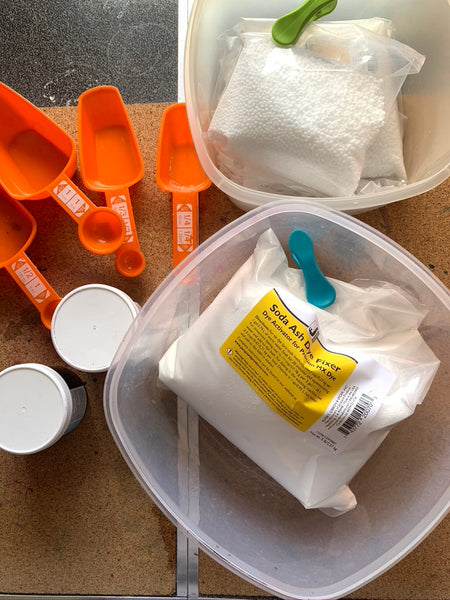Part 2: Shibori Dyeing Materials and Supplies
This is part 2 of my creative education series focused on Shibori Dyeing. In case you missed it, here is Part 1: What is Shibori Dyeing.

In this post, I will cover the basic materials and supplies you will need.
Fabric:
While there are many fabrics that can be used for shibori dyeing, I feel that lightweight fabrics work best. My preference is to use cotton, cotton muslin, habotai silk or raw silk.
Regular cotton has a tighter weave and higher thread count, whereas cotton muslin has a looser weave and lower thread count. I’ve dyed both types of fabric and they work equally well.

Habotai silk is a plain weave silk cloth that can be used to make blouses, dresses, scarves and other lightweight accessories. It is inexpensive and easy to dye and paint on. Raw silk is another fabric option. Though it is more expensive, the dyed results are beautiful.
When selecting a fabric to dye, think about what the final use for it will be. When I dye fabric for the purpose of making napkins, placemats, table runners or drawstring pouches, I use cotton muslin. When I hand dye tea towels, I use 100% cotton.

If you are new to shibori dyeing, I recommend starting with cotton muslin or habotai silk.
Binding and Clamping Materials:
Binding or clamping fabric can be done with a variety of inexpensive materials that you may already have at home or you can buy from Home Depot or a general dollar store.
When binding with stitch I like to use cotton thread or embroidery floss. Other materials I use for binding include elastic bands and string.
For clamping fabric into folded packets, I use binder clips, metal clamps, plastic or wood boards.

Wherever the fabric is clamped or bound, a resist is created and the dye will be blocked from that area.
Dyes:
There are three types of dyes that I like to use: Fiber Reactive Procion Dyes, Dylon Dyes and RIT Liquid Dye.

Fiber reactive procion dyes are a powder dye that must be mixed with a fixative in order to be permanent and “stick” to the fabric. This fixative is called soda ash and is dissolved in hot water first before the dye is added. Though not required, I also add urea which helps to keep the fabric damper during the “fixing” or curing process, allowing for deeper and brighter colors.
Though procion dyes are colorfast, I do find over time, they can fade.

Dylon dyes, also a powder dye requires regular table salt to be added to the dye bath which acts as a fixative agent, similar to what soda ash does for procion dyes. I find that Dylon dyes produce bright colors even after the fabric is dry. These dyes are colorfast and do not fade or wash away over time, the way procion dyes can. When I use Dylon dyes, I make a dye bath in a bucket and do not dye fabric in the washing machine.
RIT Liquid Dye comes in a variety of colors. This liquid dye also uses table salt as it’s fixative agent. Furthermore, there is a product called RIT Color Stay Dye Fixative which can be used immediately after dyeing that will help fabric retain the color.
Other Equipment:
Protect your work area or table with plastic sheets. I like to use plastic tablecloths that I buy from a dollar store. Have plenty of old rags, towels and paper towels handy. You will need a few plastic or stainless steel buckets as well as measuring spoons, a few stirring utensils, including a whisk (these items should be reserved for dyeing only and not reused for cooking). You might also need plastic wrap, foil and aluminum trays depending on the type of dyeing project you are working on.

I highly recommend wearing rubber gloves when dyeing and rinsing fabric and a face mask when mixing the soda ash and powder dyes.

What's Next...
Stay tuned for Part 3 of this creative education series on shibori dyeing where I will show you different shibori dyeing techniques. Sign up for my email newsletter to be notified when new content is published!
In the meantime - you can watch this video tutorial on YouTube: 15 minute tutorial: How to Dye Fabric Ombre Dip Dye Style.
